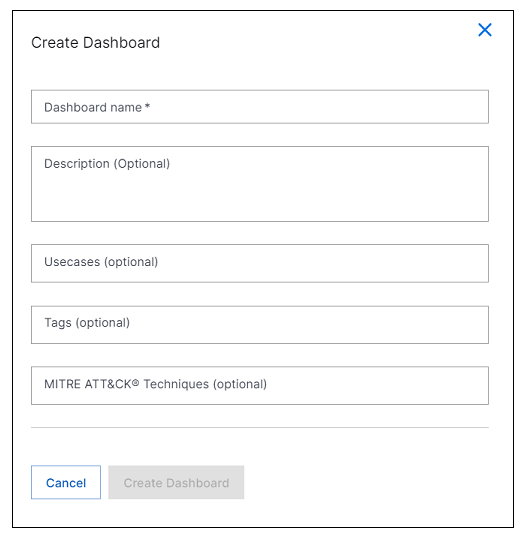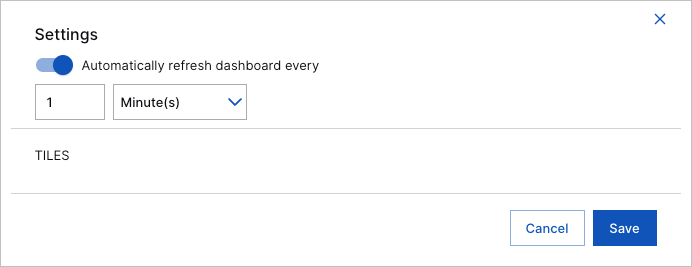- Dashboards
- Navigation Overview
- View and Interact with Dashboards
- View and Interact with Visualizations
- User Management
- Configure and Manage Dashboards
- Create a Dashboard
- Add a Visualization to a Dashboard
- Add a Text Tile
- Modify a Dashboard Layout
- Add Dashboard Filters
- Manage Automatic Refresh Rates
- Create a Scheduled Report
- Make a Dashboard Public
- Export and Import Dashboards
- Edit Dashboard Filters
- Edit Dashboard Details
- Duplicate a Dashboard
- Delete a Dashboard
- Configure and Manage Visualizations
- Create a Visualization
- Auto-Create a Visualization from a Natural Language Prompt
- Create a Visualization from a Search Query
- Add Visualizations from the Library to a Dashboard
- Modify a Visualization
- Configure Visualization Query Filters
- Include Context Filtering in Visualizations
- Make a Visualization Public
- Export and Import Visualizations
- Duplicate a Visualization
- Remove a Visualization from a Dashboard
- Delete Visualizations from the Library
- Configure and Manage Scheduled Reports
- Pre-Built Dashboards
- Advanced Analytics Dashboards
- AI/LLM Dashboards
- Case Manager Dashboards
- Compliance Dashboards
- Correlation Rules Dashboards
- Event Store Dashboards
- Access Grant and Revoke Activity
- Account Logout Summary
- Account Management Activity
- Application Security Event Summary
- Authenticated User Accounts on Hosts
- AWS CloudTrail Summary
- Data Loss Prevention Activity – Host-Based
- Data Loss Prevention Activity – User-Based
- Data Loss Prevention Activity Summary
- Default Account Access
- Default Credential Usage and Change Activity
- Denied Web Access Activity
- Disabled User Account Summary
- Discovered Attacks by Source and Destination
- Endpoint Detection and Response
- Failed Application Logon Activity
- Failed Audit Logs Summary
- Failed Host Login Attempt Counts by Users
- Failed VPN Login Attempts and Remote Session Timeouts
- Firewall Activity
- Firewall and Router Device Interfaces
- Insecure Authentication Attempts
- IOC Statistics
- Log Delay Insights
- Microsoft 365 Summary
- Microsoft Windows Overview
- Network Applications by Traffic Volume
- Policy Activity Summary
- Ports Usage Trend
- Privileged Access
- Privileged Access – User-Based
- Project Collateral
- Protocols by Network Traffic
- Remote Session Overview
- Security Alert Summary – Impacted Hosts
- Security Alert Summary – Origin Hosts
- Security Alert Summary – Users
- Successful Application Logon Activity
- Successful Database Login Activity
- Successful Physical Access
- Top Attackers
- User Account Creation Summary
- User Account Lockout Activity
- Vendor Authentication Activity
- Windows Audit Failure Summary by Hosts
- Windows Audit Failure Summary by Users
- Windows User Privilege Elevation
- Zscaler HTTP Dashboard
- Security Operations Center Management Dashboards
- Threat Center Dashboards
- Pre-Built Visualizations
- Anomalies - Use Case & MITRE Coverage
- Anomalies by Rule Name
- Anomalies by Use Case
- Anomalies Count Over Time
- Anomaly Distribution by MITRE Tactic & Score
- Application Count
- Closed Incidents
- Correlation Rules by Severity
- Correlation Rules Triggered Over Time
- Detected Anomalies
- Host-Based DLP Alerts Count
- Incidents Created
- Incident Summary by Incident Type
- Number of Hosts with DLP Alerts
- SOC Incident Distribution
- Top 5 Host-Based DLP Alert Categories
- Top 5 Protocols in Host-Based DLP Alerts
- Top 10 Host-Based DLP Alert Types
- Top 10 Hosts with DLP Alerts
- Top Activities per Top 10 Applications
- Top Users per Top 10 Applications
- Trend of Application Security Events
Create a Dashboard
The video below provides a quick overview of building a dashboard with text and visualization tiles.
To begin building a dashboard to showcase a collection of visualizations and information, you must first create the actual dashboard.
Open the Dashboards home page and make sure the Dashboards tab is displayed.
In the upper-right, click New Dashboard.
The Create Dashboard dialog box displays.

In the Create Dashboard dialog box, provide the following information:
Dashboard name – Enter a name for the dashboard.
Description – Enter a descriptions of the dashboard and its content. (Optional)
Usecases – Select one or more use case tags from the drop-down list. (Optional)
Tags – Add custom tags to the dashboard. You can select from the list of existing tags or apply a new tag. (Optional)
To create and apply a new tag, start typing a new tag name in the Tags field. Click New Tag or press Enter to save and apply the new tag.

MITRE ATT&CK® Techniques – Select one or more techniques from the drop-down list. (Optional)
Click Create Dashboard. The new dashboard is created and opens. You can opt to add a text tile or a visualization to the empty dashboard
To add a visualization tile to the dashboard, click Add Visualization. You can opt to create a new visualization or to select one that already exists in the visualization library. For more information, see Add a Visualization to a Dashboard or Create a Visualization.
To add a text tile to the dashboard, click Add Text at the top of the dashboard. An Add Text dialog box opens. For more information, see Add a Text Tile.
To set an optional automatic refresh rate for the dashboard:
In the upper-right of the dashboard, click the options menu icon (
 ) and select Refresh Settings. A Settings dialog box opens.
) and select Refresh Settings. A Settings dialog box opens.
Click the toggle to activate the Autmoatically refresh dashboard option.
Enter a number value and select a unit of time.
Click Set. The refresh rate is saved and the dialog box closes.
You can opt to set individual refresh rates for specific visualization tiles. If you set a specific tile refresh rate, it will override the dashboard refresh rate. For more information about configuring refresh rates, see Manage Automatic Refresh Rates.
To resize and move the tiles on the dashboard, see Modify a Dashboard Layout. (Optional)
When you are finished configuring the dashboard, click Save.
If you want to make the dashboard available to other Dashboards users, click Publish. (Optional) If you decide not to publish it, the saved dashboard is marked with a Draft tag and is not visible to other users. You can choose to publish a draft dashboard later.